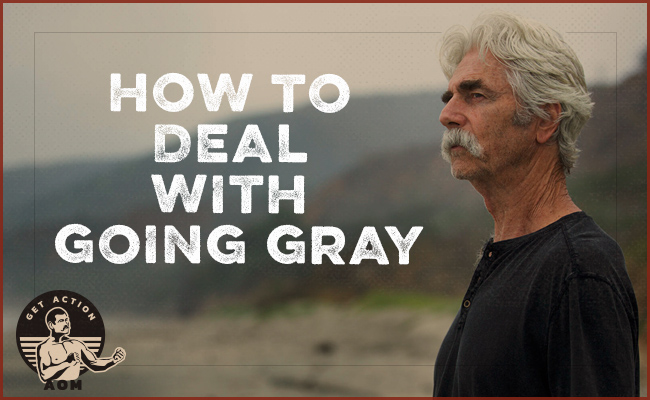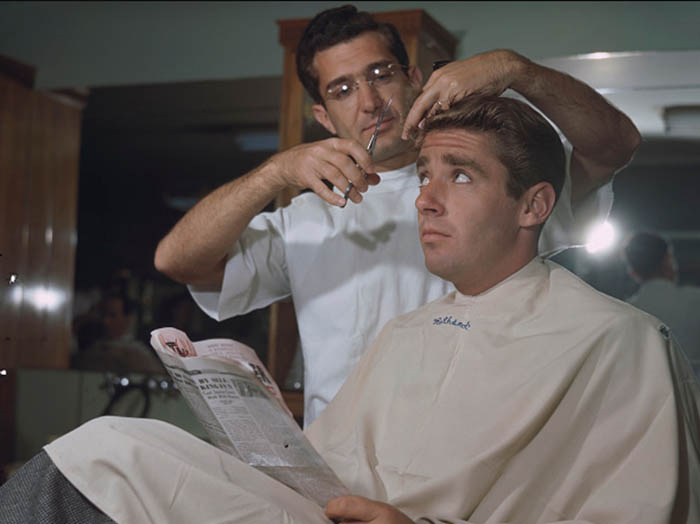Six years ago, I was 30 and had a healthy, thick, wavy black mane.
Today I’m 36 and half my hair is gray and wiry.
My son, Gus, was looking at a picture of me from when I was 30 and asked: “Dad, how did you get so old, so fast?”
Great question, son.
Going gray didn’t happen overnight. I remember spotting a few gray strands in my late twenties. A few years later, I saw some more. Then one day I woke up, looked in the mirror, and saw as much salt as pepper.
I’ve never freaked out about going gray and have never thought about dyeing my hair back to its youthful color. Even in high school my friends described me as grandpa-like, and I actually always looked forward to getting older.
But while I’ve never worried about going gray, I have been curious about it.
What caused me to go gray at such a relatively young age? Was it stress? Genetics? A combination of both?
And now that I have gray hair, do I need to do anything different with my hair care and grooming to make it look its best?
To answer those questions, as well as get the scoop on dyeing your hair for those men who’ve considered it, I did some research and talked to Thad Forrester, owner of Hudson / Hawk Barber & Shop.
Why Does Hair Go Gray?
Each one of your hairs grows out of a hair follicle, and each follicle contains cells called melanocytes. Melanocytes produce two types of pigments, or colors: eumelanin, which is dark brown or black, and pheomelanin, which is reddish yellow. Eumelanin and pheomelanin blend together to give you your hair color. (Dermatologists will often refer to eumelanin and pheomelanin simply as “melanin.”)
When melanocytes in the hair follicle start to die, the strand of hair gets less melanin as it grows and takes on a more transparent color. Gray hair is hair that’s still getting a bit of melanin, but not enough to lend the hair its youthful hue. White hair is hair that’s not getting any melanin at all. Once a melanocyte cell dies, there’s no resurrecting it — it’s dead forever, and it will never produce melanin again. Barring some breakthrough in bioengineering (or dyeing your hair), once hair goes gray, it’s gray for good.
Besides giving hair its color, melanin also helps make hair smooth and lush. Consequently, gray, melanin-deprived hair often gets a wiry or coarse texture and it becomes increasingly difficult to style and manage.
So that’s the mechanism behind hair going gray — its pigment-producing cells die. But what causes those melanin cells to expire in the first place?
Scientists don’t really know.
Age certainly plays a factor and is of course why we associate going gray with getting old. As you get older, all of your body’s cells start to die and malfunction, including the cells that make hair color.
But some people go gray sooner and some people keep their color well into old age.
What gives?
There’s a popular theory that stress causes people to go gray. To bolster this argument, you’ll often see side-by-side pictures of American presidents the day they started their term and the day they ended their term. The President of the United States is arguably one of the most stressful jobs a person could have, so if a man grays considerably during his administration, we figure it was the stress that caused it, right?
Well, maybe. And maybe not. While there’s plenty of anecdotal evidence that stress causes people to go gray, scientific studies that have looked into the matter have been mixed. There’s some evidence to suggest that stress hormones could disrupt melanin being delivered to your hair strands, which would cause it to go gray, but again, it’s not conclusive. With the graying of presidents’ hair, it could just be a function of getting older; 8 years is a fairly long time, after all.
So stress may or may not play a role in when you go gray. The most significant factor, according to science, is likely your genetics. If your parents went gray at a young age, then the chances of you going gray young are increased.
So what do you do when you start going gray yourself? Should you dye your hair? If you don’t dye it, do you have to change anything with your hair care? Let’s explore those questions.
Should You Dye Your Gray Hair?
To dye or not to dye. That is the question.
Graying hair is less disconcerting to men than losing hair, and unlike Western women, who are pressured to maintain their youthful looks, and hair color, for as long as possible, we males generally have the luxury of letting the aging process take its natural course. Gray hair is distinguished on a man. It makes him look wise, seasoned, and sometimes even sexy.
But if you’re in your 20s and 30s, gray hair can feel like it’s prematurely taking the sheen off this last season of youthful virility. And an older man who works in a youth-driven industry, or is back on the dating scene after being divorced or widowed, may also feel pressure to look less stodgy. If you fall into these categories and/or simply feel the desire to dye your hair, keep the following considerations in mind:
If there are just a few spots of gray on your head — like at your temples — you might consider dyeing only those patches with something like Just for Men AutoStop. With this kind of product, you don’t have to dye all of your hair (though you can), just the parts that are going gray. It’s relatively easy to use (you just comb it in and let it sit for 10 minutes before you shower), and it lasts for up to 8 weeks.
If you’re already pretty salt and peppery and you want to color all of your hair, do so gradually. If you go from George Clooney to Keanu Reeves overnight, people are going to notice. To gradually color your hair back to a more youthful color, try something like Just for Men Control GX which is hair dye in a shampoo; as you use it over the course of a month, more and more of your gray is colored, and you can stop once you’ve achieved the desired effect.
A lot of men’s drugstore/DIY hair dyes don’t actually cover all of your gray, and that’s okay; it can look more natural to still have some showing.
The downside of off-the-shelf/DIY hair coloring products, especially if you’re dyeing all your hair and want close to 100% gray coverage, is that you’re limited in the colors you can choose from. As Thad explains, “Natural hair colors and tones are extremely varied, but [men’s] color dyeing products give you like four color options to choose from — black, dark brown, light brown, and blonde. If you color with a product like that, it’s not going to match your natural hair color and things are going to look off.” When your hair’s a monotone color, it looks flat and fake, like you rubbed your hair with shoe polish.
Thad says if you truly want a better-looking end result, you need to visit a professional who specializes in hair color: “The reason women look great when they color their hair and men typically look bad is because women pay a professional a lot of of money to make it look as natural as possible, while a man will typically opt for the DIY approach. Professional hair colorers can do a better job of matching natural hair color compared to what you can get out of a box.” Traditional barbers typically aren’t trained in hair coloring, so you’ll need to visit a salon.
But before you book an appointment with a hairdresser or pick up a box of Just for Men, consider the many downsides of coloring your hair (always thoroughly read through the Amazon reviews for dyes to understand what you’re getting yourself into):
1. You have to dye your hair every 3-8 weeks. Every month and half or so (depending on how fast your hair grows, how often you get your haircut, and how frequently a particular formula of dye is applied), you’re either going to have to visit a hairdresser to dye it, a process that can take up to an hour, or go through the rigmarole of dyeing your hair at home (which is considerable: you’ve got to apply vaseline around your hairline to keep it from staining your skin, clean up stains on your countertops and hands, and so on).
2. You have to keep dyeing it for-ev-ver (or until your age surpasses your vanity). To keep your hair colored, you’ll have to keep up the dye jobs indefinitely. Once you stop, your hair, especially if it’s gone predominantly gray, will look funny growing back. Before you start dyeing, imagine yourself signing a contract with Just for Men, agreeing to use their product until 2050. As that’s essentially what you’re doing, if you’re not comfortable with that commitment, think twice about starting to color your hair.
3. It costs $$$. Getting your hair colored at a salon can cost $25-$100. That’s really going to add up over time, which again, can be decades.
4. Dyes can be harsh on hair. Hair dye contains chemicals that can sometimes make your hair fall out. Gray hair ages you, but so does thin hair.
5. No matter how natural the hair color, dyed hair never looks completely natural on a man. No hair dye — even those created by a salon — completely matches your original hair color, and even when it’s close, it still doesn’t look quite right, at least on older guys: our brains are used to seeing older women with colored hair, but don’t expect to see older men with such, so when you see a guy with a 50-year-old face, but completely jet black hair, it just registers as being a little off. You realize he dyes his hair, calling attention to it, and his age, and making him seem a little vain and insecure — the very opposite effect from what he’s looking for!
For these reasons, Thad and most male barbers recommend that men who are starting to go gray just let the process take its course. “It’s just easier to manage than dyeing your hair, [and] it looks good, and shows a lot of confidence in a guy,” Thad said.
Embracing the Silver Fox: How to Take Care of Gray Hair
As mentioned above, gray hair is caused by a reduction in melanin. Besides causing your hair to turn gray, a decrease in melanin also makes your hair wiry and harder to manage. So if you decide to embrace your gray hair, there are some changes you’ll need to make to your grooming routine to ensure your new silver mane looks its best:
1. Opt for a shorter haircut. If your hair is still thick, despite the fact it’s going gray, Thad says you still have a lot of options on how to cut and style it. “There are a lot of men with longer gray hair that look good.” (Paging Sam Elliott.) If you’re going to go longer with your gray mane, ask for a cut with more texture. A textured cut involves the barber cutting your hair at an angle which gives it some volume and movement compared to cutting your hair straight across.
While it’s possible to go long with gray hair, Thad likes to steer men with graying locks to cuts that are short on the sides and a little longer on the top (think Clooney). “I like to use clippers on the sides and the back and use some textured cuts on the top,” he said. “A short haircut lets you hide or blend the gray more compared to longer haircuts. Short gray hair is also easier to manage and style than long gray hair. Also, there’s something about a short haircut that takes the years off of a man’s face, so if you’re worried about gray hair making you look old, a shorter haircut can counteract that.”
2. Use a product with a bit of shine. As gray hair loses its natural shine (thanks to the lack of melanin), Thad recommends avoiding completely matte hair products when styling: “Matte products make your hair look a bit dull which is something you don’t want to do when you have gray hair because gray hair is already dull.”
Thad likes semi-matte hair products for gray hair, which have some shine, but not so much that it looks unnatural. A couple specific recommendations from Thad were Cardinal Atlas texturing clay and Firsthand Supply texturing clay.
One product that I’ve had success with on my gray hair is Mitch Construction Paste. It holds my hair without getting crunchy, has a bit, but not too much, shine, and includes conditioning ingredients to reduce some of the wiry-ness of my grays.
3. Don’t shampoo your hair as frequently. Thad told me that most men, including men with no gray hair, shampoo their hair way more than they need to. But shampooing your hair less frequently is even more important when you have gray hair. “Every time you shampoo your hair, you’re washing away your hair’s natural oils. You only need to shampoo your hair a few times a week. This is especially true for men with gray hair since gray hair is already naturally drier,” he said.
Instead of shampooing every time you shower, do it every other day or so.
4. Consider a hair oil. To tame the wirey-ness of your gray hair, try a hair oil, which softens and moisturizes the hair. If you’re having trouble with the coarseness of your gray hair, Thad recommends rubbing in a few drops after you shower.
5. Consider using shampoo and conditioner made especially for gray hair. Once a week use what’s called a “purple shampoo.” It’s called a purple shampoo because it’s, well, purple. They’re designed to make your gray hair look bright and vibrant rather than dull and yellow. Thad recommends talking to someone who specializes in hair color before you start using a “purple shampoo,” though, because while “They can help remove brassy tones from your hair over time . . . it’s possible to overdo it with these shampoos.”
If you reduce how often you shampoo, and use the right hair product and perhaps a hair oil, your gray hair will be in good shape, and you can confidently step into your maturity and enjoy your status as a silver fox.
______________________________________________________________
Thanks to Thad from Hudson / Hawk Barber & Shop (locations in Springfield, Columbia, and Kansas City, Mo, and Betonville, AR) for his tips.
Further Resources:








